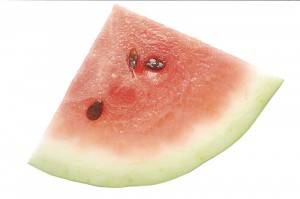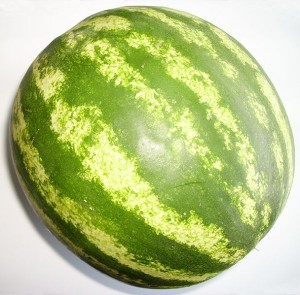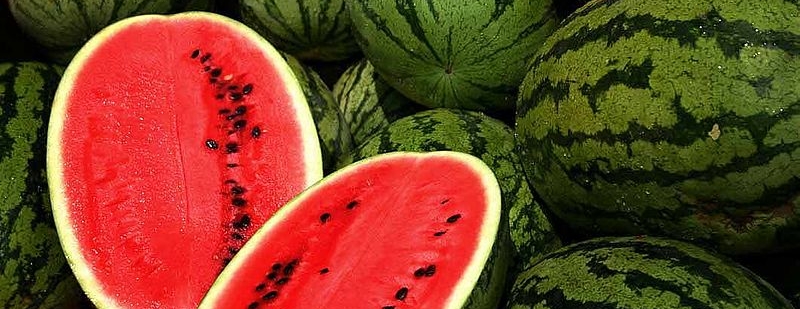 Citrullus lanatus: A Summertime Favorite
Citrullus lanatus: A Summertime Favorite
The watermelon is a vine like flowering plant originally from S. Africa (family Cucurbitaceae). It is related to the cucumber, pumpkin and cantaloupe. The watermelon fruit is referred to by botanists as a pepo, a berry with a thick rind and fleshy center. The flesh of the watermelon may range from red to pink, and sometimes orange, yellow or white. It grows wild in southern Africa, reaching maximum genetic diversity with sweet, bland and bitter forms. There is evidence of its cultivation in the Nile Valley from the second millennium B.C., and seeds were also found in the tomb of the Pharaoh Tutankhamun.
Watermelons were cultivated in China by the 10th century, now the world’s largest watermelon producer (even introducing “square” watermelons). It was introduced to Europe in the 13th century, and according to John Mariani’s Dictionary of American Food and Drink, “watermelon” made its appearance in an English dictionary in 1615. Native Americans cultivated the fruit in the 16th century, and it may have been introduced to Massachusetts as early as 1629. By 1954, Charles Frederic Andrus set out to produce a disease and wilt resistant watermelon. Mr. Andrus was a horticulturalist at the USDA Vegetable Breeding Laboratory in Charleston, South Carolina, and his creation became known as “that gray melon from Charleston”. Today, most commercially grown watermelon varieties have some “Charleston Gray” in their lineage.
 A watermelon is about 6% sugar and 91% water by weight, and like many fruits, is a good source of Vitamin C. Despite some information to the contrary, the seedless watermelon is not a result of genetic manipulation, but hybridization.
A watermelon is about 6% sugar and 91% water by weight, and like many fruits, is a good source of Vitamin C. Despite some information to the contrary, the seedless watermelon is not a result of genetic manipulation, but hybridization.
The watermelon rind, though often discarded, actually has a very high concentration of nutrients (horses love them). In other countries, they are often used as a vegetable. Chinese cooking, for example, uses the peeled rind stir-fried, stewed and more commonly, pickled. In the stir-fry, it is cooked with olive oil, garlic, chili peppers, scallions, sugar and rum. Apparently, pickled watermelon rind is popular in the southern U.S. also. Watermelon juice may be made into wine, and Covington’s own Kombucha Girl (at the Saturday Farmer’s Market) makes a fantastic Watermelon Water Kefir now that they are in season. You can find watermelons at the Covington Farmer’s Market and local farms like Stoney Point Farm in Amite, who often sells watermelons in the Covington area.
Phenolic compounds in watermelons (flavonoids, caratenoids) offer some anti-inflammatory and antioxidant support. The redder the watermelon, the higher its content of lycopene, and some studies show watermelon may contribute to antihypertensive effects. Always consult a professional for advice regarding the nutritional benefits of foods that best fit your situation.




